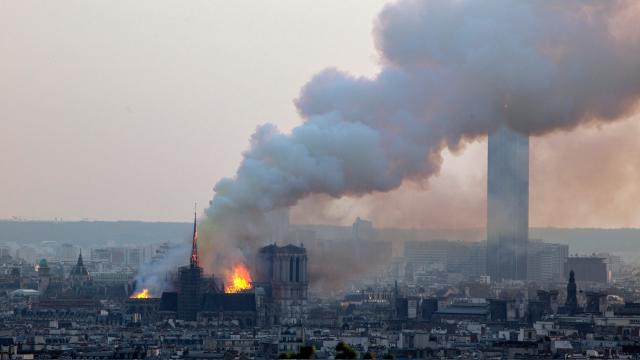The tragic Notre Dame cathedral fire last year produced more lead fallout than was initially reported by French authorities, potentially putting nearby residents at risk, new research suggests.
On April 15, 2019, the roof and spire of Paris’s iconic Notre Dame cathedral caught fire and collapsed, in an event that shocked the world. Around 460 tons of lead covered the cathedral in the form of lead roof tiles and other building materials, leading to concerns that some of this toxic metal, made airborne by the fire, might have rained down onto surrounding neighbourhoods.
French officials said the amount of lead that had fallen near the cathedral hadn’t accumulated to dangerous levels. New research published in GeoHealth is contradicting this claim, finding lead fallout near the cathedral at levels well above the country’s safety limit.
After the fire, the Regional Health Agency of France measured soil near the cathedral, finding levels of lead below 300 milligrams per kilogram (mg/kg), which is the country’s acceptable limit. This caused a bit of upset in France, as some people thought officials were downplaying the health risks.
“There was a controversy — were children being exposed or not from this fallout?” said Alexander van Geen, the lead author of the new paper and a geochemist at Columbia University, in a press release. “So I thought, whether I get a ‘yes’ or a ‘no,’ it’s worth documenting.”
Lead is a neurotoxic metal that’s particularly dangerous to children. The U.S. Centres for Disease Control (CDC) says kids normally become exposed by eating or chewing lead-based paint chips or objects covered in lead-based paint, or by ingesting house dust or soil contaminated with lead.
“Once it enters the body, lead can become a health hazard. Lead can affect almost every organ and system in the body, especially the nervous system,” according to the CDC. “It can cause learning disabilities and behavioural problems. At very high levels, it can cause seizures, coma, and even death. Lead poisoning frequently goes unrecognised because it often occurs with no obvious symptoms.”
The goal of the study was to determine the extent to which people in Paris were exposed to lead as a result of the cathedral fire. To that end, soil samples were collected in all directions around Notre Dame. The researchers collected 100 soil samples within a 2 km radius (1 kilometre) of the cathedral, in December 2019 and again in February 2020.
“It wasn’t a particularly glamorous expedition,” explained van Geen. “I got plenty of strange looks from people wondering why this old guy was scooping up soil, trying to avoid the dog poop, and putting some of the soil in paper bags. But it got done.”
Normally, soil should have lead at less than 100 mg/kg, but the samples in the study area were found to contain 200 mg/kg. Downwind of the fire, to the northwest of the cathedral, these levels were more than twice as high, registering 430 mg/kg of lead, which is well above France’s 300 mg/kg safety limit. Around 998 kg of lead (1,000 kg) likely settled within the study area after the fire, according to the researcher’s models.
“Although the estimated amount of lead redeposited within 1 km corresponds to only a small fraction of the total covering the cathedral, it could have posed a health hazard to children located downwind for a limited amount of time,” wrote the authors in the study.
Study co-author and statistician Yuling Yao, also from Columbia University, said in the press release these findings should be “validated by more data, especially when they have profound policy and public health consequences,” to which he added: “I hope our work sheds some light in that direction.”
Larger environmental tests should have happened after the fire, the authors conclude. This would have offered a more timely assessment of the situation, alerting health officials to the danger. In turn, they could have warned people in the affected areas, advising residents to wipe away indoor dust and prevent children from playing in the soil, among other safety measures.
